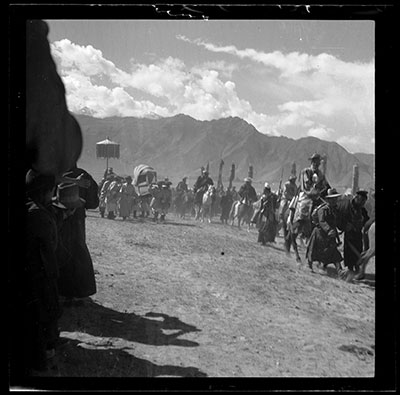
2001.59.14.39.1 (Film negative)


2001.59.14.39.1 (Film negative)

Hugh E. Richardson
Hugh Richardson
October 8th1939
Lhasa Area > Doguthang Rikya
2001.59.14.39.1
55 x 55 mm
Riding , Ritual Activity
Negative film nitrate
Donated August 2001
The executors of the estate of Hugh E. Richardson
Hugh E. Richardson
Manual Catalogues - Notes on negative album (outer case) - (on front) 'Kodak NEGATIVE FILE' in red and yellow lettering and a white label with 'Z.' in black ink'; (on reverse) 'Kangchenjunga. Gangtok Dances. RETURN of DL. Yak dancers etc. BIRDS etc.'; the letter 'A' in the top left hand corner and '8' in the right hand corner all written in white. (On spine on yellow "Subjects" label) ' GANGTOK . LHASA . PEOPLE . D.L. animals Birds; [Dates] 1936-40' written in Richardson's hand in blue ink; (below the label) the number '8' in white overwritten by the letter 'A' in pencil. Notes on negative album - (on cover) '8, Kangchenjunga. Gangtok Dances. RETURN of DL 1939. Yak dancers. Lhamo. Officials Tests. BIRDS...'. (On the spine) "KODAK NEGATIVE FILE 2 1/4 X 2 1/4 IN. (6 X 6 CM.) in embossed gold lettering; the letter "A" in white in Richardson's hand. Notes on negative index inside the negative album under 'Subject' - 'DLs camping chair'
Other Information - Location: This appears to be the state-level reception camp which the Tibetan government prepared to receive the young Dalai Lama before he reached Lhasa proper on his way from his home in Amdo. A description of this reception camp may be found in 'Discovery, Recognition and Enthronement of the 14th Dalai Lama' compiled by Khemey Sonam Wangdu, Sir Basil J. Gould and Hugh E. Richardson, Dharamsala: LTWA/Paljor Publications. "The tents at Doguthang were arranged in three rings (an inner, middle and outer circle), and the sight was magnificent, resembling rings of heavenly bodies twinkling in a starry night. At the very centre was the Dalai Lama's own marquee made of superfine yellow brocade and called the "Great Peacock". Surrounding it were tents for his bed, prayers, dining and so forth all furbished in the fashion of typical Mongol tents, using tiger and leopard skins and the best quality yellow brocade. The next two rings consisted of the tents of the regent, the prime minister, the young Dalai Lama's family, the lay ministers, secretary-level civil service officials from grades one to three, and officials from the Potala and Downtown Treasury." [KC 14/2/2006]
Other Information - Setting: Michael Harris Goodman describes the occasion of the Dalai Lama being formally greeted by the Tibetan Government in The Last Dalai Lama, 1986, London: Sidgwick & Jackson, "Finally they reached Dogu-thang, barely three miles outside, where new Dalai Lamas were traditionally accorded a formal welcome by the Tibetan government. // In the middle of the vast plain was erected the yellow satin Peacock Tent used solely for such occasions. Fifteen feet high and covering an area of over one hundred feet square, it had a yellow silk lining and a silk top and was used by the new Dalai Lama for religious audiences; smaller tents for him to sleep, pray, dress and eat were pitched in a rectangular formation around it, and these in turn were surrounded by scores of other tents to accommodate monastic and lay officials as well as foreign delegations from Britain, China, Nepal, Sikkim, and Bhutan. For the better part of two days the Dalai Lama sat calmly on his throne, benignly bestowing his blessings on high dignitaries, monks and commoners, alike. The impassive yet affable manner of the child impressed all who saw him, although his family found quite amusing his apparent preoccupation with the two Britons: the Londoner Reginald Fox, radio operator for the British Mission, whose sandy-colored hair was most unusual in Tibet; and Hugh Richardson, the urbane Scotsman heading the mission, who was resplendent in full diplomatic gear including plumes and spurs. The child's fascination notwithstanding, Richardson eventually gave up wearing the spurs because he could find no way to do so comfortably while sitting on cushions in the prescribed cross-legged fashion. // Clusters of government workers and monks scurried about distributing ceremonial pastries and dried fruits to the thousands of celebrants, and a huge trough of dried yak meat was provided from which allure encouraged to grab what they could because doing so would bring prosperity to the land. Everywhere people were gathered in groups singing, offering prayers, and performing regional folk dances." (p. 61)
Other Information - Setting: The Dalai Lama writes about the occasion in his autobiography Freedom in Exile, 1990, London: Hodder & Staughton, "At last, our party began to draw near to Lhasa. It was by now autumn. When we were within a few days' journey, a group of senior officials came out to meet us and escorted our party on to the Doeguthang plain, two miles outside the gates of the capital. There, a huge tented encampment had been erected. In the centre was a blue and white structure called the, Macha Chenmo, the 'great Peacock'. It looked enormous to my eyes and enclosed an intricately carved wooden throne, which was only ever brought out for the purpose of welcoming the infant Dalai Lama back home." (pp. 15-16)
For Citation use:
The Tibet Album.
"Dalai Lama's sedan chair being carried at Doguthang"
05 Dec. 2006. The Pitt Rivers Museum.
<http://tibet.prm.ox.ac.uk/photo_2001.59.14.39.1.html>.
For more information about photographic usage or to order prints, please visit the The Pitt Rivers Museum.
© The Pitt Rivers Museum